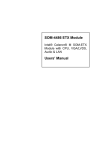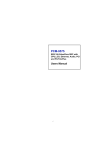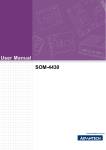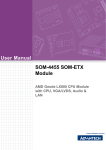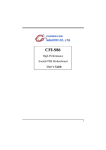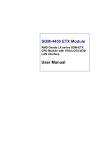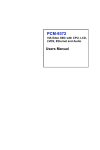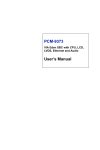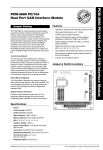Download Advantech SOM-4450 ETX User`s manual
Transcript
SOM-4472 ETX Module VIA Eden/Ezra SOM-ETX CPU Module with CPU, VGA/LCD/ LAN/Audio Interface User's Manual Copyright notice This document is copyrighted, 2002, by Advantech Co., Ltd. All rights are reserved. The original manufacturer reserves the right to make improvements to the products described in this manual at any time without notice. No part of this manual may be reproduced, copied, translated or transmitted in any form or by any means without the prior written permission of the original manufacturer. Information provided in this manual is intended to be accurate and reliable. However, the original manufacturer assumes no responsibility for its use, nor for any infringements upon the rights of third parties which may result from its use. Acknowledgements SOM and DTOS are trademarks of Advantech Co., Ltd. AMD is a trademark of Advanced Micro Devices, Inc. Award is a trademark of Award Software International, Inc. Cyrix is a trademark of Cyrix Corporation. IBM, PC/AT, PS/2 and VGA are trademarks of International Business Machines Corporation. Intel and Pentium are trademarks of Intel Corporation. Microsoft Windows® is a registered trademark of Microsoft Corp. RTL is a trademark of Realtek Semiconductor Co., Ltd. C&T is a trademark of Chips and Technologies, Inc. UMC is a trademark of United Microelectronics Corporation. Winbond is a trademark of Winbond Electronics Corp. STPC is a trademark of SGS Thomson Corp. For more information on this and other Advantech products, please visit our website at: http://www.advantech.com For technical support and service, please visit our support website at: http://support.advantech.com This manual is for the SOM-4472 Part No. 2006447200 1st Edition Printed in Taiwan June 2002 ii Packing list Before you begin installing your card, please make sure that the following materials have been shipped: • 1 SOM-4472 System On Module CPU module • CD-ROM or Disks for utility, drivers, and manual (in PDF format) If any of these items are missing or damaged, contact your distributor or sales representative immediately. Additional Information and Assistance 1. Visit the Advantech web site at WWW.advantech.com where you can find the latest information about the product. 2. Contact your distributor, sales representative, or Advantech's customer service center for technical support if you need additional assistance. Please have the following information ready before you call: . Product name and serial number . Description of your peripheral attachments . Description of your software (operating system, version, application software, etc.) . A complete description of the problem . The exact wording of any error messages iii Contents CHAPTER 1 General Information .................................. 1 1.1 1.2 1.3 Introduction ....................................................................... 2 Specifications .................................................................... 3 1.2.1 Standard System On Module functions ....................... 3 1.2.2 VGA/flat panel Interface ............................................ 4 1.2.3 Audio function ............................................................ 4 1.2.4 TV-out ........................................................................ 5 1.2.5 PCI bus Ethernet interface ........................................ 5 1.2.6 Mechanical and environmental ................................... 5 Board dimensions ............................................................ 6 CHAPTER 2 Connector Assignments........................... 9 2.1 2.2 2.3 Connector Locations ..................................................... 10 Pin Assignments for X1, X2, X3, X4 connectors ....... 11 Safety precautions .......................................................... 11 CHAPTER 3 Software Configuration (optional) ......... 13 3.1 3.2 3.3 3.4 Introduction ..................................................................... 14 Utility CD disk ................................................................ 14 VGA display software configuration ............................ 14 Connections for two standard LCDs ........................... 16 3.4.1 Connections for Toshiba LTM10C042(640 x 480 TFT color LCD) ......................................................................... 16 3.4.2 Connections for Toshiba LTM12C275A (800 x 600 TFT color LCD) ................................... 17 APPENDIX A Programming the Watchdog Timer ....... 19 APPENDIX B System Assignments ............................ 23 B.1 B.2 B.3 B.4 System I/O ports ............................................................ 24 DMA channel assignments ........................................... 25 Interrupt assignments ................................................... 26 1st MB memory map ..................................................... 27 iv CHAPTER 1 General Information This chapter gives background information on the SOM-4472 CPU System On Module. Sections include: • Introduction • Specifications • Board Dimensions 1.1 Introduction The SOM-4472 is a VIA low-power Eden/Ezra processor System On Module (SOM) with audio controller, a 4X AGP SVGA controller, a PCI 10/100Base-T Ethernet interface. Using an VIA Eden/Ezra processor, the SOM-4472 achieves quite good performance on the SOM-ETX CPU module. On-board features include two serial ports, one multimode parallel (ECP/EPP/SPP) port, four USB (Universal Serial Bus) ports, a floppy drive controller, and a keyboard/PS/2 mouse interface. The built-in high-speed PCI IDE controller supports both PIO and UDMA/33 bus master modes. Up to two IDE devices can be connected, including large hard disks, CD-ROM drives, and tape backup drives. The SOM-4472 features power management to minimize power consumption. It complies with the "Green Function" standard and supports Doze, Standby and Suspend modes. In addition, the board's watchdog timer can automatically reset the system or generate an interrupt if the system stops due to a program bug or EMI.The small size (95 mm x 114 mm) and use of four high capacity connectors based on the proven SOM-ETX form factor, allow the SOM-ETX modules to be easily and securely mounted onto a customized solution board or our standard SOM-DB4400 development board. The SOM-4472 is a highly integrated multimedia SOM that combines audio, video, and network functions. It provides 16-bit half-duplex, 8bit full-duplex, integrated 3D audio, and up to 1024 x 768 resolution @ 16.8 M colors with 8/16/32 MB system memory. Major on-board devices adopt PCI technology, to achieve outstanding computing performance when used with VIA Eden/Ezra processors. The SOM4472 also supports TV-out that supports NTSC/PAL format for multimedia applications. 2 SOM-4472 User's Manual 1.2 Specifications 1.2.1 Standard System On Module functions • CPU: Onboard VIA Ezra 800 MHz (SOM-4472F-Q0A1& SOM-4472FL-Q0A1) or Eden 400 MHz processor (SOM-4472F-J0A1&SOM-4472FL-J0A1) • BIOS: Award 256KB Flash memory • Chipset: VIA PL133 chipset, VT8606T(TwisterT) & VT82C686B • Cache memory: 128KB L1 and 64KB L2 cache memory on the processor • System memory: One 144-pin SO-DIMM socket accepts 64 ~ 512 MB SDRAM • Power management: Supports power saving modes including Normal/Standby/Suspend modes. APM 1.2 compliant • Enhanced IDE interface: 2 EIDE channels support up to 4 IDE devices. BIOS auto-detect, PIO Mode3 or Mode4, UDMA/33 transfer • FDD interface: Supports one FDD share with Parallel Port • Infrared: One 115 Kbps infrared port, IrDA compliant • Parallel port: One parallel port, supports SPP/EPP/ECP parallel mode • Serial port: two serial ports, COM 1: RS-232 and COM 2 : RS-232 (TTL Output) • Watchdog timer: 62 level timer intervals. Generates system reset and jumperless selection and software enabled/disabled • Keyboard/mouse connector: Supports standard PC/AT keyboard and PS/2 mouse interface • USB interface: Four USB connectors compliant with USB Spec. Rev. 1.1 Chapter 1 General Information 3 1.2.2 VGA/flat panel Interface • Chipset: VIA Twister chip with integrated Savage4 2D/3D/Video Accelerator • Frame buffer: Supports 8/16/32 MB frame buffer with system memory • Display type: Simultaneously supports CRT and flat panel displays. Also supports up to 18-bit TFT LCD panels(SOM-4472FQ0A1&SOM-4472F-J0A1) and 2 Channel LVDS interface(SOM4472FL-Q0A1&SOM-4472FL-J0A1) • Display mode: CRT Mode: 1280 x 1024 @ 32bpp (60Hz), 1024 x 768 @ 32bpp(85Hz); LCD/Simultaneous Modes: 1280 x 1024 @16bpp(60Hz), 1024 x 768 @16bpp(60Hz) 1.2.3 Audio function • Chipset: VIA 82C686 South Bridge • Audio controller: AC97 Ver. 2.0 compliant interface, Multistream Direct Sound and Direct Sound 3D acceleration • Stereo sound: 8-bit full-duplex • Audio interface: Microphone in, Line in, Line out 4 SOM-4472 User's Manual 1.2.4 TV-out • Chipset: VIA VT1621 • Supports NTSC, NTSC=EIA (Japan) and PAL TV formats • Provides Composite video and S-video outputs via RCA (composite) connector and S-video connetor • Supports 640 x 480 and 800 x 600 input resolutions • Supports Windows © 95/98/NT and Windows XP drivers 1.2.5 PCI bus Ethernet interface • Chipset: REALTEK RTL8139 Ethernet controller • Ethernet interface: IEEE 802.3U compatible 100/10Base-T interface. Includes software drivers and boot ROM 1.2.6 Mechanical and environmental • Dimensions (L x W): SOM-ETX form factor, 95 mm x 114 mm (3.7" x 4.5") • Power supply voltage: +5 V ± 5% • Power requirements: Max: 4.5 A @ +5 V Typical: 3.4 A @ +5 V, (with 256MB DRAM, Ezra 800 MHz CPU) 2.88 A @ +5 V (with 256 MB DRAM, Eden 400 MHz CPU) • Operating temperature: 0 ~ 60° C (32 ~ 140° F) • Operating humidity: 0% ~ 90% Relative Humidity, Noncondensing • Weight: 0.074 Kg (weight of total package) Chapter 1 General Information 5 1.3 Board dimensions Figure 1-1: SOM-4472 dimensions 6 SOM-4472 User's Manual Figure 1-2: SOM-4472 Top view Chapter 1 General Information 7 8 SOM-4472 User's Manual CHAPTER 2 Connector Assignments and Descriptions This chapter tells how to set up the SOM4472 hardware. It includes instructions on connecting peripherals, switches and indicators. Make sure you read all the safety precautions before you begin the installation procedure. 2.1 Connector Locations The board has a number of connectors that allow you to configure your system to suit your application. The tables below shows the function of each of the board's connectors: SOM-4472 Locating Connectors 10 SOM-4472 User's Manual 2.2 Pin Assignments for X1, X2, X3, X4 connectors Please refer to SOM-ETX Design and Specification Guide, Chapter 2 2.3 Safety precautions Warning! Always completely disconnect the power cord from your board whenever you are working on it. Do not make connections while the power is on, because sensitive electronic components can be damaged by a sudden rush of power. Caution! Always ground yourself to remove any static charge before touching the board. Modern electronic devices are very sensitive to static electric charges. Use a grounding wrist strap at all times. Place all electronic components on a static-dissipative surface or in a static-shielded bag when they are not in the chassis. Chapter 2 Connectors and Pin Assignments 11 12 SOM-4472 User's Manual CHAPTER 3 Software Configuration (optional for SOM-4472) This chapter details the software configuration information. It shows you how to configure the SOM-4472 card to match your application requirements. Sections include: • LCD display configuration • Connections for two standard LCDs 3.1 Introduction The SOM-4472 system BIOS and custom drivers are located in a 256 KB, 32-pin Flash ROM. A single Flash chip holds the system BIOS and VGA BIOS. The display type can be configured via software. This method minimizes the number of chips and eases configuration. You can change the display BIOS simply by reprogramming the Flash chip. 3.2 Utility CD disk The SOM-4472 is supplied with a software utility on CD-ROM. This disk contains the necessary file for setting up the VGA display. Directories and files on the disk are as follows: AWDFLASH.EXE 4472Vxxx.BIN AWDFLASH.EXE This program allows you to update the BIOS Flash ROM. 4472110.BIN This binary file contains the system BIOS. 3.3 VGA display software configuration The SOM-4472 on-board VGA/LCD interface supports an 18-bit TFT LCD, flat panel displays and traditional analog CRT monitors. The interface can drive CRT displays with resolutions up to 1280 x 1024@32 bpp. It is also capable of driving color panel displays with resolutions of 1280 x 1024 @ 16bpp. The LCD type is configured completely via the software utility, so you do not have to set any jumpers. Configure the LCD type as follows: 14 SOM-4472 User's Manual 1. Apply power to the SOM-4472 application with a color TFT display attached. This is the default setting for the SOM-4472 series. Make sure that the AWDFLASH.EXE and *.BIN files are located in the working drive. Note: Make sure that you do not run AWDFLASH.EXE while your system is operating in EMM386 mode. 2. At the prompt, type AWDFLASH.EXE and press <Enter>. The VGA configuration program will then display the following: Figure 3-2: BIOS VGA setup screen 3. At the prompt, type in the BIN file which supports your display. When you are sure that you have entered the file name correctly press <Enter>. The screen will ask “Do you want to save?” If you wish to continue press Y. If you change your mind or have made a mistake press N. 4. If you decide to continue, the screen will issue a prompt which will then ask “Are you sure to program (Y/N)?” If you wish to continue, press Y. Press N to exit the program. The new VGA configuration will then write to the ROM BIOS chip. This configuration will remain the same until you run the AWDFLASH.EXE program and change the settings. Chapter 3 Software Configuration 15 3.4 Connections for two standard LCDs 3.4.1 Connections for Toshiba LTM10C042(640 x 480 Table Connections TFT 3-1: color LCD) for Toshiba LTM10C042 16 LTM10C042 SOM-4450 Pin 1 2 3 4 5 6 7 8 9 10 11 12 13 14 15 16 17 18 19 20 21 22 23 24 25 26 27 28 29 30 31 Pin 3 35 4 27 28 29 8 30 31 32 33 19 20 21 33 22 23 24 34 37 34 11 12 13 39 14 15 16 39 5 6 Name GND CLK GND R0 R1 R2 GND R3 R4 R5 GND G0 G1 G2 GND G3 G4 G5 GND ENAB GND B0 B1 B2 GND B3 B4 B5 GND VDD VDD SOM-4472 User's Manual Name GND SHFCLK GND PD12 PD13 PD14 GND PD15 PD16 PD17 GND PD6 PD7 PD8 GND PD9 PD10 PD11 GND M GND PD0 PD1 PD2 GND PD3 PD4 PD5 GND +5 V +5 V 3.4.2 Connections for Toshiba LTM12C275A (800 x 600 TFT color LCD) Table 3-2: Connections for Toshiba LTM12C275A LTM12C275A Pin Name SOM-4450 Pin 1 GND 3 GND 2 NCLK 35 SHFCLK 3 NC - NC 4 NC - NC 5 GND 4 GND 6 R0 27 PD12 7 R1 28 PD13 8 R2 29 PD14 9 R3 30 PD15 10 R4 31 PD16 11 R5 32 PD17 12 GND 8 GND 13 G0 19 PD6 14 G1 20 PD7 15 G2 21 PD8 16 G3 22 PD9 17 G4 23 PD10 18 G5 24 PD11 19 GND 33 GND 20 B0 11 PD0 21 B1 12 PD1 22 B2 13 PD2 23 B3 14 PD3 24 B4 15 PD4 25 B5 16 PD5 26 ENAB 37 M/DE 27 GND 34 GND 28 VCC 5 +5 V 29 VCC 6 +5 V 30 GND 39 GND Name Chapter 3 Software Configuration 17 18 SOM-4472 User's Manual APPENDIX A Programming the Watchdog Timer A.1 Programming the watchdog timer To program the watchdog timer, you must write a program which writes I/O port address 443 (hex). The output data is a value of time interval. The value range is from 01 (hex) to 3E (hex), and the related time interval is 1 sec. to 62 sec. Data Time Interval 01 1 sec. 02 2 sec. 03 3 sec. 04 4 sec. • • • • • • 3E 20 62 sec. SOM-4472 User's Manual After data entry, your program must refresh the watchdog timer by rewriting the I/O port 443 (hex) while simultaneously setting it. When you want to disable the watchdog timer, your program should read I/O port 443 (hex). The following example shows how you might program the watchdog timer in BASIC: 10 REM Watchdog timer example program 20 OUT &H443, data REM Start and restart the watchdog 30 GOSUB 1000 REM Your application task #1, 40 OUT &H443, data REM Reset the timer 50 GOSUB 2000 REM Your application task #2, 60 OUT &H443, data REM Reset the timer 70 X=INP (&H443) REM, Disable the watchdog timer 80 END 1000 REM Subroutine #1, your application task • • • • • • 1070 RETURN 2000 REM Subroutine #2, your application task • • • • • • 2090 RETURN Appendix A Programming the Watchdog Timer 21 22 SOM-4472 User's Manual APPENDIX B System Assignments • System I/O ports • DMA channel assignments • Interrupt assignments • 1st MB memory map B.1 System I/O ports Table B-1: System I/O ports Addr. range (Hex) 000-01F 020-03F 040-05F 060-06F 070-07F 080-09F 0A0-0BF 0C0-0DF 0F0 0F1 0F8-0FF 1F0-1F8 200-207 278-27F 2F8-2FF 300-31F 360-36F 378-37F 380-38F 3A0-3AF 3B0-3BF 3C0-3CF 3D0-3DF 3F0-3F7 3F8-3FF 443 Device DMA controller (slave) Interrupt controller 1, (master) 8254 timer/counter 8042 (keyboard controller) Real-time clock, non-maskable interrupt (NMI) mask DMA page register, Interrupt controller 2 (slave) DMA controller (master) Clear math co-processor Reset math co-processor Math co-processor 1st fixed disk Game I/O Reserved Serial port 2 Ethernet** LPT2 Parallel printer port 1 (LPT1) SDLC, bisynchronous 2 Bisynchronous 1 Monochrome display Reserved Color/graphics monitor adapter Diskette controller Serial port 1 Watchdog timer ** default setting 24 SOM-4472 User's Manual B.2 DMA channel assignments Table B-2: DMA channel assignments Channel 0 1 2 3 4 5 6 7 Function Available Available Floppy disk (8-bit transfer) Parallel** Cascade for DMA controller 1 Available Available Available ** Parallel port DMA default setting: DMA 3 Parallel port DMA select: DMA 1, 3 Appendix B System Assignments 25 B.3 Interrupt assignments Table B-3: Interrupt assignments Interrupt# NMI IRQ 0 IRQ 1 IRQ 2 IRQ 3 IRQ 4 IRQ 5 IRQ 6 IRQ 7 IRQ 8 IRQ 9 IRQ 10 IRQ 11 IRQ 12 IRQ 13 IRQ 14 IRQ 15 Interrupt source Parity error detected Interval timer Keyboard Interrupt from controller 2 (cascade) Serial communication port 2 Serial communication port 1 Available Diskette controller (FDC) Parallel port 1 (print port) Real-time clock Reserve Available Reserved for watchdog timer PS/2 mouse INT from co-processor Preliminary IDE Secondary IDE for CompactFlash USB and Ethernet IRQ is automatically set by the system 26 SOM-4472 User's Manual B.4 1st MB memory map Table B-4: 1st MB memory map Addr. range (Hex) Device F000h - FFFFh E000h - EFFFh CC00h - DFFFh C000h - CB00h B800h - BFFFh B000h - B7FFh A000h - AFFFh 0000h - 9FFFh System ROM Reserved for BIOS boot available VGA BIOS CGA/EGA/VGA text Reserved for graphic mode usage EGA/VGA graphics Base memory * default setting Appendix B System Assignments 27 28 SOM-4472 User's Manual


































